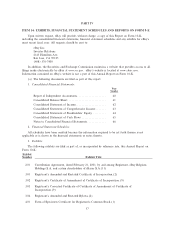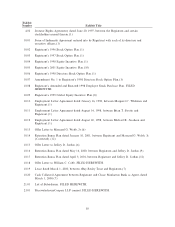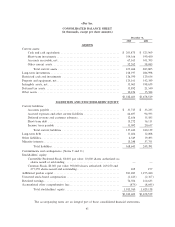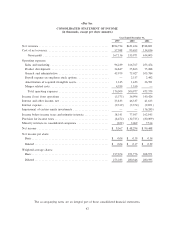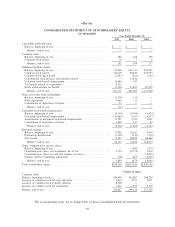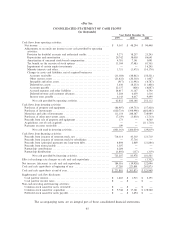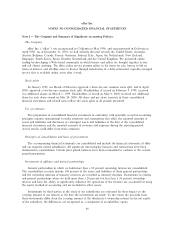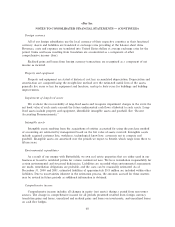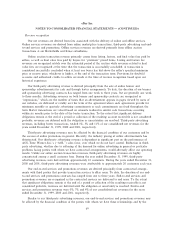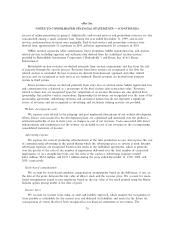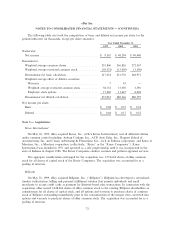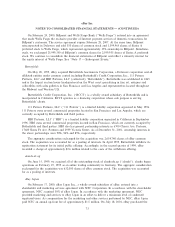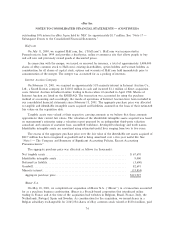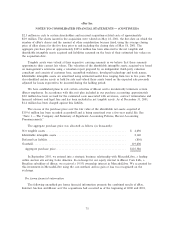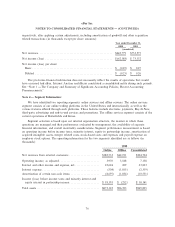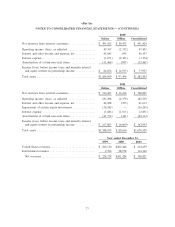eBay 2001 Annual Report Download - page 71
Download and view the complete annual report
Please find page 71 of the 2001 eBay annual report below. You can navigate through the pages in the report by either clicking on the pages listed below, or by using the keyword search tool below to find specific information within the annual report.eBay Inc.
NOTES TO CONSOLIDATED FINANCIAL STATEMENTS Ì (CONTINUED)
Fair value of Ñnancial instruments
Cash and cash equivalents are short-term, highly liquid investments with original maturities of three
months or less when purchased. Our Ñnancial instruments, including cash, cash equivalents, accounts
receivable, and accounts payable are carried at cost, which approximates their fair value because of the
short-term maturity of these instruments.
Short and long-term investments, which include marketable equity securities, municipal, government
and corporate bonds are classiÑed as available-for-sale and reported at fair value using the speciÑc
identiÑcation method. Realized gains and losses are included in earnings. Unrealized gains and losses are
excluded from earnings and reported as a component of other comprehensive income (loss), net of related
estimated tax provisions or beneÑts. Additionally, we assess whether an other-than-temporary impairment
loss on our investments has occurred due to declines in fair value or other market conditions. Declines in
fair value that are considered other than temporary are recorded as charges in the statement of income.
Derivative instruments
We recognize all derivative instruments on the balance sheet at fair value. Changes in the fair value
(i.e., gains or losses) of the derivatives are recorded each period in the statement of income or other
comprehensive income (loss). For a derivative designated as a cash Öow hedge, the gain or loss on the
derivative is initially reported as a component of other comprehensive income (loss) and subsequently
reclassiÑed into the statement of income when the hedged transaction aÅects earnings. For derivatives
recognized as a fair value hedge, the gain or loss on the derivative in the period of change and the
oÅsetting loss or gain of the hedged item attributed to the hedged risk, are recognized in the statement of
income. For derivatives not recognized as hedges, the gain or loss on the derivative in the period of
changes is recognized in the statement of income.
Concentrations of credit risk
Our cash, cash equivalents, investments and accounts receivable are potentially subject to
concentration of credit risk. Cash, cash equivalents and investments are deposited with Ñnancial institutions
that management believes are of high credit quality. Our accounts receivable are derived from revenue
earned from customers located in the U.S. and internationally. The revenues earned from the U.S. site are
denominated in U.S. dollars and revenue earned from our international sites are denominated in the
country's functional currency. Accounts receivable balances are typically settled through customer credit
cards and, as a result, the majority of accounts receivable are collected upon processing of credit card
transactions. We maintain an allowance for doubtful accounts receivable based upon our historical
experience. Historically, such losses have been within our expectations. However, unexpected or signiÑcant
future changes in trends could result in a material impact to future statements of income or cash Öows.
Generally, due to the relatively small dollar amount of individual accounts receivable, we do not require
collateral on these balances. The provision for doubtful accounts is recorded as a charge to operating
expense, while the provision for authorized credits is recognized as a reduction of revenues.
We also entered into two interest rate swaps with two separate Ñnancial institutions to reduce our
interest rate exposure on our lease payments. If either of these Ñnancial institutions should fail to deliver
under these contracts, we may be subject to variable interest rate payments. During the years ended and as
of December 31, 1999 and 2000, no customers accounted for more than 10% of net revenues or net
accounts receivable. As of December 31, 2001, one customer represented approximately 20% of net
accounts receivable.
67


